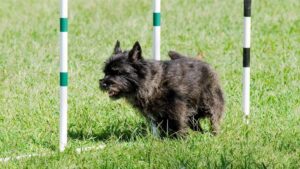
Cairn Terriers in Agility
Explore the world of Cairn Terriers in Agility! Learn how these tenacious Terriers excel in the fast-paced sport.
Home » Dog Breeds » Cairn Terrier Dog Breed



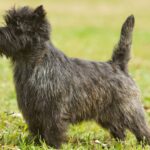


The Cairn Terrier is originally from Scotland, dating from the 17th century when it was closely linked with other types of terriers. The breed was first known as the Shorthaired or Prick-Eared Skye Terrier. Then, in the 19th century, it was named the Cairn for its capacity to root out vermin sheltering in rock piles (cairns). This breed is independent, intelligent, loyal, and friendly; however, they don’t enjoy being left alone at home for too long since they like to regularly express their affection for their family.
Terrier Group
9.5 – 10 Inches
13-14 Pounds
13-15 Years
| Country of Origin | Scotland |
|---|---|
| Bred For | Rooting Small Prey from Rock Piles, Companionship |
| Known For | Courage, Intelligence, Tenacity, Independency, Friendliness |
| Popularity | Moderate |
| Activities | Working on Farms, Digging, Exploring, Therapy Dog, Conformation Shows, Dog Sports |
The Cairn Terrier originates from the Isle of Skye and is recognized as one of Scotland’s earliest recognized working dogs. One of the smallest of the go-to-ground terriers, the Cairn was developed to dig into cairns and flush out smaller creatures. In its native land, a “cairn” is a mound of stones used as a boundary or grave marker where rodents liked to live. The local dogs would also hunt in packs to pursue foxes, otters, and other predators. The Cairn’s independence, courage, toughness, and awareness served it well when digging and when it was confronted by sharp-toothed quarry.
Cairns were known from the 1600s, but initially, this breed was categorized as a form of “Skye Terrier“ alongside the ancestors of the Scottish and West Highland White Terriers. A Highland sportsman by the name of Captain Martin MacLeod used his dogs to hunt otters. Later enthusiasts included a gamekeeper named Mr. John Macdonald who carried on Macleod’s Drynock strain as the 20th century approached. All of his dogs descended from the Cairn’s earliest progenitors.
In 1912, The Royal Kennel Club of the United Kingdom gave the Cairn Terrier a separate breed designation. In 1912, the first year of recognition, 134 Cairn Terriers were registered, and shortly afterwards, the breed was given Championship status.
While most Cairn Terriers are no longer used for their original purpose, they remain independent and feisty small dogs that enjoy hunting, digging, and playing with their people. Thankfully, the range and availability of canine sports has grown rapidly in recent years, and there’s a dog sport that’s ideal for every Cairn.
The height of the adult male Cairn Terrier is 10 inches at the withers; mature females typically measure 9.5 inches tall.
In terms of weight, a healthy male typically weighs 14 pounds, while the female generally weighs 13 pounds.
The Cairn Terrier is a small, short-legged breed with a well-proportioned build overall. Its general appearance is easily recognizable and has not changed much over time. The breed’s body is compact and of medium length, with a level back. This dog has sloping shoulders, deep and well-sprung ribs, strong muscular thighs, and a good bend of stifle, characteristics that support its working role as a hunter of vermin in tight spaces. Consequently, the Cairn is noted for its strong but not heavy body when compared with similar terrier breeds.
Texture: The coat of the Cairn Terrier is weather-resistant, consisting of a wiry, harsh, and profuse outer coat that is free from coarseness, and soft, short, and close undercoat. The hair on the head may be somewhat softer than the body coat, but still harsh enough to offer protection from brairs.
| Standard Color | |
|---|---|
| Brindle | ee |
| Cream | ee |
| Gray | ee |
| Gray Brindle | ee |
| Red | ee |
| Red Brindle | ee |
| Silver | ee |
| Wheaten | ee |
| Cream Brindle | ee |
| Black | ee |
| Black Brindle | ee |
| Red Wheaten | ee |
| Silver Brindle | ee |
| Wheaten Brindle | ee |
| Silver Wheaten | ee |
A Note About Color: The Cairn Terrier’s coat can be any color except white, solid black, or black and tan. Dark points on the ears and muzzle are very typical, as is brindling on any acceptable color.
| Standard Marking | |
|---|---|
| Black Point | ee |
| Black Mask | ee |
| Black Markings | ee |
The tail of a Cairn Terrier is moderate in length, straight, thick, and strong. It is set on at the level of the back and is wider at the base than at the tip. The tail is furnished with dense hair and is carried between the 12 and 2 o’clock position. It should never curl over the back when the dog is moving.
The Cairn Terrier, with its friendliness, playfulness, and loyalty, is a great choice among single dog people and families. However, as with any breed and mixed breed, the breed’s high level of energy and its hunting instincts come with responsibilities that should be considered before acquiring a Cairn.
The Cairn Terrier is typically a healthy animal, but like all dogs, some individuals may be prone to genetic health issues due to indiscriminate breeding practices. This is why it’s always best to contact a preservation breeder who is a member of a Cairn Terrier club for information about obtaining a new puppy or adult dog.
Lifespan: The average lifespan of the Cairn Terrier is 13 to 15 years, but with proper care, a balanced diet, and regular check-ups, many can thrive even beyond these years.
Although generally a healthy breed, some Cairn Terriers may be prone to certain health conditions, including:
The Cairn Terrier is a real terrier; independent, alert, and intelligent. However, the Cairn is also wonderfully friendly and outgoing. Temperament, it should be noted, can be affected by several factors such as heredity, training, and socialization.
Early socialization is always key. Exposure to different people, sights, sounds, and experiences while young is important for the Cairn. This breed is happy and cheerful, and typically enjoys meeting new people. Of course, these dogs are devoted to family and like to be a part of their owners’ lives. Playing with kids can be their favorite activity at home. It’s important to note that Cairns are very sensitive and don’t like being left alone for too long.
Cairns are curious dogs and are quick to learn. Due to their independence and stubbornness, however, they must know who is in charge. Otherwise, they will take control of things themselves. Early training and socialization tend to help with this sometimes challenging situation.
Because of the Cairn’s high energy level, the top of the list of activities that can be expected are digging, barking, and chasing. When outdoors, these dogs will chase any small animal if given the chance. For example, cats, rabbits, and even small dogs can be considered their quarry. Because of this, they should always be walked on a leash in public places and given a free-run only in a securely fenced yard. Cairns are typically good watchdogs and will always announce visitors.
Overall, the Cairn Terrier is a family dog and a wonderful companion. The breed needs to be in the house or wherever its family goes. It is a great choice for people who want an independent, playful, and alert companion that desires (demands) to be by their side.
The Cairn Terrier should thrive on a high-quality food, whether purchased commercially or cooked at home with a veterinarian’s guidance. The daily amount of food that is recommended is one-half to one cup, divided into two meals.
The Cairn’s diet should be tailored to the age of the dog (puppy, adult, or senior), and its size, build, metabolism, and activity level. Highly active dogs will need more food than those that are less active.
High-quality food provides more nourishment, so less will be needed. The food should be measured and split into two meals per day rather than one. Also, it’s important never to leave food out all day and avoid feeding prepackaged food for people; however, if needed, it is safe to supplement with natural foods such as carrots, peppers, blueberries, broccoli, and cauliflower.
In case of a lack of nutrients in the dog’s food, the best supplements to give a Cairn are multivitamins, omega-3 fatty acids, and fish oil.
To check if a Cairn is overweight, both the eye test and the hands-on test should be given. When looking down on the dog, a waist should be apparent. By placing hands on the back and thumbs along the spine, it should be possible to feel, but not see, the ribs. If this is not the case, the dog needs less food and more exercise. Before making any changes to a Cairn’s diet, it’s essential to always check with a veterinarian first.
The Cairn Terrier is a breed known for its lively and tenacious nature. This zest for life, combined with an innate intelligence, makes this dog both a joy to own and a challenge to train.
For those wondering about the Cairn’s ease of training, these dogs can be quite independent. They have a strong-willed nature, often making them appear rather stubborn. This doesn’t mean they’re untrainable, however. It just requires a consistent and patient approach. Positive reinforcement methods, using treats or praise, typically work best with this breed. Cairns often respond well to rewards, and this can be a great incentive for them to learn.
When it comes to vocalizations, Cairns are known to be quite expressive. They might not always bark without a reason, but they’re certainly not silent dogs. Their barking could be in response to unfamiliar sounds or strangers, thus making them decent watchdogs. It’s essential to teach them the “quiet” command early on to manage any unnecessary barking.
In terms of intelligence, this breed is undoubtedly smart. The Cairn’s intelligence, combined with a curious nature, can sometimes lead this dog into mischief if not directed appropriately. Training sessions should be regularly provided, but kept short and engaging to hold the student’s attention.
Lastly, the Cairn Terrier’s predation instinct is something to consider. Given the breed’s history as a hunter of small vermin, these dogs have a relatively high prey drive. While this might not pose a problem for most people, those with smaller pets like hamsters or birds should be cautious.
A big dog in a small package, that’s what the Cairn Terrier is. This is a tireless and high-energy dog that approaches life with zest. The Cairn is intelligent and quick to learn, so this vigor is not just about running around. Many of these dogs enjoy companion and performance events, and most like to dig. So, Barn Hunt may be a great activity for expending excess energy while having a good time.
| Energy Level | High |
|---|---|
| Exercise Requirements | 1 Hour/Day (Minimum), Daily Walks, Vigorous Running, Regular Exercise, Playing with Another Dog, Mental Stimulation |
The exercise needs of Cairn puppies are different from those of adults, since their bodies are developing and not yet fully mature. Play should be supervised and regular periods of rest need to be scheduled. Older Cairns, despite their graying muzzles and stiffened joints, should still be active enough to maintain muscling and mobility.
Daily walks are essential to release the Cairn’s energy reserves. These excursions must be up to one hour a day in length, and two walks a day are best, if possible. Without this exercise, this dog can develop behavior issues such as barking, digging, and even going on an unscheduled exploration.
The three main types of exercise for this breed would be daily walks, high-intensity playtime, and mental stimulation. Cairns should be provided with the right kind of toy as a great way to burn energy and stimulate their active minds.
The Cairn Terrier is double-coated, which helps the breed through different climate changes. The coat is profuse and weather-resistant and protective, although it does shed throughout the year. Regular grooming is required to keep the coat in fine condition.
| Coat Type | Double, Wiry |
|---|---|
| Grooming Requirements | Weekly Brushing, Occasional Bathing, Intermittent Hand-Stripping, Routine Ear Cleaning, Periodic Nail Trimming, Regular Tooth Brushing |
Weekly brushing and combing should be done to check the hair and skin, and hand-stripping is necessary to maintain the coat’s proper texture.
Because of the Cairn Terrier’s water-resistant coat, bathing is recommended only once every few months. If bathed more often, there’s a chance of damaging the hair and their natural protective oils. When bathing, it’s important to always choose a shampoo for a “hard“ coat.
Trimming should be done by a professional groomer and includes some trimming of hair around the Cairn’s eyes for both aesthetic and health reasons. Also, it’s important to make sure the dog’s feet are trimmed, since this is an active breed that is always ready for adventure.
Lastly, the Cairn Terrier’s nails should be trimmed regularly, because overgrown nails are uncomfortable for the dog and can even cause pain. Trimmed nails are essential and allow the dog to move freely without discomfort.
Energetic, curious, independent, and healthy is everything a Cairn Terrier is. The nature of this breed is one of adaptability, whether the dog is living in an apartment or a countryside home. The Cairn can happily thrive in just about any living environment.
If a person’s lifestyle necessitates frequent travel or a relocation, the Cairn will be highly adaptable to the change and will eagerly welcome the new surroundings. The breed’s adaptability makes it ideal for families that value flexibility in their lives.
Because of the Cairn’s double, weather-resistant coat, this breed adapts well to living in a variety of climates. The soft and furry undercoat keeps the dog cool in the summer heat and warm in the winter or when it’s raining. The breed’s undercoat does an amazing job at keeping these dogs dry.
Although small in size, the Cairn Terrier is big in terms of energy. The level of energy is typically high, and this requires regular walks and exercise to expend that accumulated energy. Mental stimulation is also important for Cairns to prevent them from developing behavior problems and even becoming aggressive out of frustration and boredom.
When contemplating a Cairn as a family companion or introducing it to other animals, compatibility must be considered. While these dogs can be fantastic with children and other pets when properly socialized, understanding the breed’s prey drive and energy levels is key for managing relationships effectively.
Cairn Terrier puppies are playful and full of energy from an early stage of life. Their curiosity, combined with their instinct for digging and playing, can make them a bit harder to keep calm; however, if trained and socialized early on, they can be great company for just about anyone.
Before bringing home a Cairn Terrier puppy, it’s best to make sure a safe and nurturing environment is provided. Since this breed is very active from a young age, constant supervision is required to prevent any harm. Providing the puppy with toys will help with its teething as well as its play needs.
During the puppy’s growth stages, nutrition is critical. It’s best to feed a young Cairn a high-quality puppy food to ensure it gets all the nutrients needed for healthy growth. Setting a regular feeding schedule is also a good idea and will assist with housebreaking.
Regular veterinary check-ups are crucial in the first year of life. Vaccinations, deworming, and basic health checks should be performed to provide the puppy with a healthy start in life.
Training a Cairn Terrier puppy at an early stage will encourage it to grow into a well-behaved adult. Important aspects of puppy care include basic training and socialization. Socialization will instill confidence and can even reduce the chances of fearfulness or aggression later in life.
The Cairn Terrier is a pretty versatile dog and is known for its intelligence, fearlessness, and adaptability. Although first bred for work on the farm to dig vermin from rock piles, over the years it has been involved in a variety of activities and dog sports, showcasing the breed’s many skills.
The Cairn Terrier is recognized by the world’s leading registries and kennel organizations, which categorize the breed into a specific Group based on its unique characteristics. This breed is recognized worldwide under the following Group designations:
| Organization | Group Designation |
|---|---|
| AKC (American Kennel Club) | Terrier |
| UKC (United Kennel Club) | Terrier |
| CKC (Canadian Kennel Club) | Terriers |
| ANKC (Australian National Kennel Council) | Terriers |
| RKC (The Royal Kennel Club) | Terrier |
| FCI (Fédération Cynologique Internationale) | Group 4 – Terriers; Section 2 – Small-Sized Terriers |
The ideal Cairn Terrier is described by a Breed Standard that is approved by each of the world’s leading registries and kennel organizations. The Breed Standards for this breed may be found in the following links:
| Organization | Breed Standard |
|---|---|
| American Kennel Club | AKC Cairn Terrier Breed Standard |
| United Kennel Club | UKC Cairn Terrier Breed Standard |
| Canadian Kennel Club | CKC Cairn Terrier Breed Standard |
| Australian National Kennel Council | ANKC Cairn Terrier Breed Standard |
| The Royal Kennel Club | RKC Cairn Terrier Breed Standard |
| Fédération Cynologique Internationale | FCI Cairn Terrier Breed Standard |
Cairn Terrier clubs are indispensable in preserving the breed’s written Standard, promoting responsible breeding practices, and fostering a community for enthusiasts and breeders alike. These organizations often serve as hubs for education, organized events, and advocacy for the Cairn Terrier as a unique breed.
The Cairn Terrier Club of America (CTCA) is a dog club dedicated to supporting and promoting quality in the purebred breeding of Cairn Terriers. The organization strongly urges members and mentor-breeders to embrace the Breed Standard as specified by the CTCA and recognized by the American Kennel Club as the only requirement of excellence by which Cairn Terriers will be judged.
The Cairn Terrier Club of Canada (CTCC) stands as the premier organization in Canada for Cairn Terrier enthusiasts. The club was formed by a small group of Cairn fanciers in 1952.
The United Kingdom operates a few clubs, including The Cairn Terrier Club which is the oldest club for Cairns in the world, and the Southern Cairn Terrier Club, which is approved by The Royal Kennel Club.
Joining or engaging with these and similar clubs provides Cairn Terrier enthusiasts with a wealth of knowledge and opportunities to connect with others who share the same passion for this affable breed.
Sadly, not every Cairn Terrier puppy is placed in a loving forever home. When acquired without sufficient research and knowledge, some dogs can end up in adoption or foster situations.
In the United States, Cairn Rescue USA is one of the dedicated rescue organizations for the breed. This group is dedicated to rescuing, rehabilitating, and finding new homes for Cairns in need. In addition, the Cairn Terrier Club of America contains a detailed list of hard-working regional rescues.
Canadian Cairn Terrier Rescue is the leading rescue organization in Canada. This group of volunteers operates under the broader umbrella of the Cairn Terrier Club of Canada and has found homes for hundreds of Cairns looking for a new lease on life.
In the United Kingdom, the most popular rescue group for the breed is the Cairn Terrier Relief Fund. This organization was established in 1969 and provides care for abandoned or neglected Cairns as well as those whose owners can no longer take care of them for any reason.
The Cairn Terrier has a typical lifespan of around 13 to 15 years, though some can live even longer with proper care. It’s important to note that a balanced diet, regular exercise, and consistent veterinary care are essential factors for ensuring a long and healthy life.
Cairn Terriers are considered to be a low to moderate shedding breed. While they do shed, their shedding is not excessive. Regular grooming and brushing can help to manage the hair loss, and pet Cairns particularly benefit from regular visits to professional groomers.
The Cairn Terrier is a small breed, standing around 9.5 to 10 inches tall at the shoulders. It’s worth noting that the size of the individual dog can vary, so it’s important to acquire one from a reputable breeder known for producing dogs that conform to the Breed Standard.
Cairn Terriers are generally quite agile and can run at speeds of around 15 to 20 miles per hour, depending on the individual fitness and energy level of the dog. While the breed has moderate activity needs, it’s notable that the Cairn has a natural inclination to dig, often displaying this behavior while exploring its surrounding environment.
Cairn Terriers typically weigh between 13 and 14 pounds. While there’s a general weight range, the size and weight of an individual Cairn can vary. So, when looking to acquire one, it’s best to consult with breeders who are known for producing dogs that fit within the desired specifications.
Yes, the Cairn Terrier is known for its affectionate and lively nature, making these dogs excellent family companions. They generally get along well with children and other pets when socialized from a young age. The breed’s versatility is well-suited for people in all stages of life, from young families to active adults and the elderly.
The Cairn Terrier is not considered hypoallergenic. While no dog is completely hypoallergenic, some breeds are less likely to trigger allergies in sensitive individuals due to their low-shedding (or absent) coats. Cairns do shed to some extent, which can potentially cause allergies in people who are prone to them. Regular grooming and cleaning can help with controlling any allergens.
A Cairn Terrier typically reaches its full-grown size and physical maturity at around 12 to 18 months of age. By this time, most will have achieved their adult height and weight. To encourage optimum health during the later years, it’s essential to feed the Cairn a high-quality diet and provide regular opportunities to exercise.
Cairn Terriers are known for their loyalty and often form strong bonds with their human companions. While they can be sociable and friendly towards the entire family, it’s not uncommon for them to display a particular attachment to one specific person. This loyalty, paired with the breed’s alert and protective nature, typically makes these dogs an excellent choice for a canine companion.
Like most dogs, the Cairn Terrier prefers the company of their human family members and may experience separation anxiety if left alone for extended periods. If the dog becomes bored or anxious, it might engage in a few destructive behaviors. If a Cairn needs to be left alone regularly, it’s essential to provide it with toys and puzzles, or consider getting another companion to help mitigate the loneliness.
Cairn Terriers can be quite vocal. Their natural instinct as terriers is to alert their owners of any perceived threats, which can include unfamiliar noises or strangers approaching the house or yard. Proper training and socialization from a young age can help to manage and reduce excessive barking.
In terms of grooming, Cairn Terriers are a moderate maintenance breed. Their wiry coat requires occasional brushing and infrequent baths to maintain its natural state, and periodic stripping of the dead hairs is necessary to keep a dog looking like the champions that compete at dog shows. However, in terms of energy and mental stimulation, they are moderately high maintenance. These active little terriers benefit from regular exercise and activities that will challenge their intelligent and curious minds.

Explore the world of Cairn Terriers in Agility! Learn how these tenacious Terriers excel in the fast-paced sport.
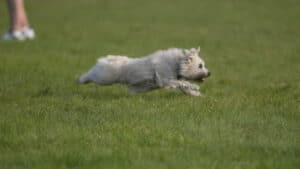
Discover the versatility of Cairn Terriers, all-around wonder dogs, capable of excelling in performance events and being perfect companions.
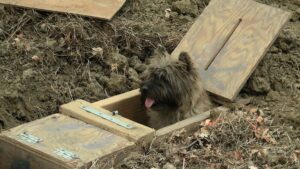
Explore the joys and challenges of training Cairn Terriers in performance sports, showcasing their ability to excel with the right approach.
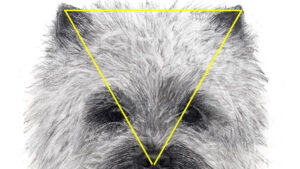
Discover the essence of the Cairn Terrier, focusing on its temperament and expression as key elements in defining breed type.
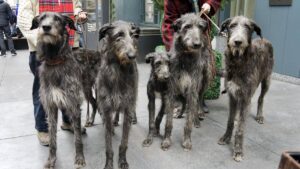
Discover the joy of Scottish heritage at the 2024 Tartan Day Parade, featuring bagpipers, dancers, and adorable Scottish dog breeds.
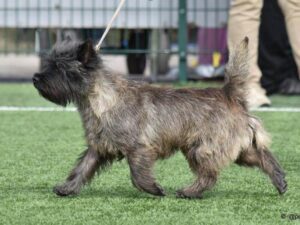
Discover the distinctive Cairn Terrier characteristics, from the breed standard to appearance. Uncover key insights into this dog breed.
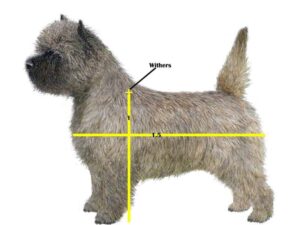
Explore Cairn Terrier proportions: Learn to judge breed type accurately, from head to body, ensuring adherence to the breed standard.
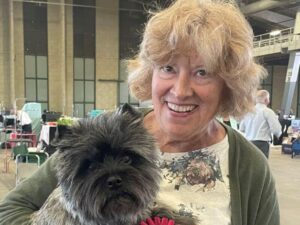
Kendall Lake is the breeder behind Lochinver Cairns. Read about the kennel’s beginnings, Cairn Terrier puppies, and much more!

Explore the world of Cairn Terriers in Agility! Learn how these tenacious Terriers excel in the fast-paced sport.

Discover the versatility of Cairn Terriers, all-around wonder dogs, capable of excelling in performance events and being perfect companions.

Explore the joys and challenges of training Cairn Terriers in performance sports, showcasing their ability to excel with the right approach.

Discover the essence of the Cairn Terrier, focusing on its temperament and expression as key elements in defining breed type.

Discover the joy of Scottish heritage at the 2024 Tartan Day Parade, featuring bagpipers, dancers, and adorable Scottish dog breeds.

Discover the distinctive Cairn Terrier characteristics, from the breed standard to appearance. Uncover key insights into this dog breed.

Explore Cairn Terrier proportions: Learn to judge breed type accurately, from head to body, ensuring adherence to the breed standard.

Kendall Lake is the breeder behind Lochinver Cairns. Read about the kennel’s beginnings, Cairn Terrier puppies, and much more!
The best way to ensure a long and happy relationship with a purebred dog is to purchase one from a responsible breeder. Not sure where to begin?
Contact the National Parent Club’s Breeder Referral Program, which is listed on the AKC Breeder Referral Contacts page.
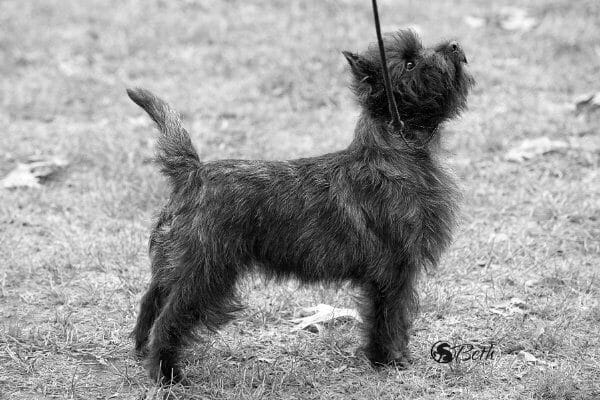

"*" indicates required fields
Showsight Magazine–the world’s most influential purebred dog publication since 1992. Each issue reaches a global audience dedicated to preserving the history and health of purpose bred dogs. Filled with award-winning editorial focused on news and insights from the dog show community, top breeders, handlers, AKC Judges, and more!